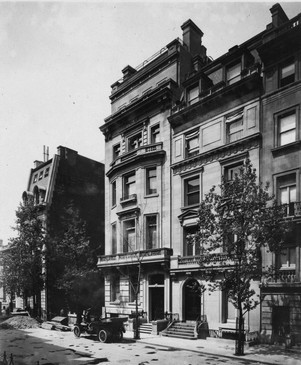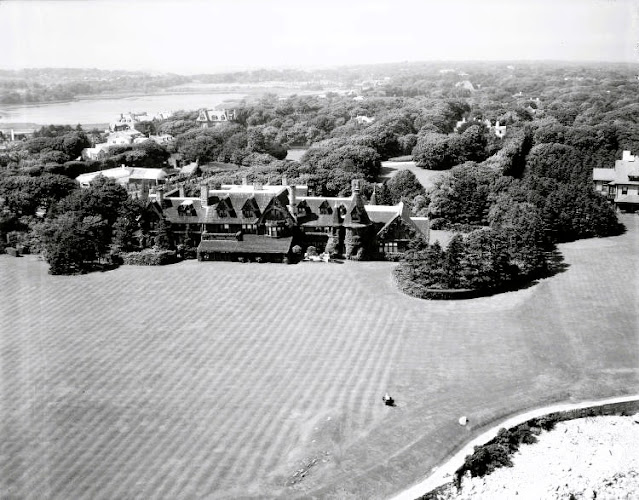photo by Wurts Bros. from the collection of the Museum of the City of New York.
In 1818 Robert Lenox paid the Corporation of the City of New York $6,920 (about $176,000 in 2025) for 30 acres of land far north of the city. He named his summer estate Lenox Farm. In his will dated May 23, 1829, he admonished that his son should keep "the property from being sold." James Lenox did (mostly) keep the property intact throughout his lifetime. But in January 1870, he donated the Fifth Avenue blockfront between 70th and 71st Street for the site of a library--the Lenox Library.
In March 1895, the Lenox, Tilden, and Astor Libraries were consolidated, creating the New York Public Library. Even before after its palatial building on Fifth Avenue was completed in 1911, plots within what the Record & Guide called "the Lenox Library block" were being sold. The Sun mentioned, "The instructions of the trustees were that sales could only be made to parties who would improve for their own resident purposes." (In other words, buyers could build only homes for their own occupancy on the plots.)
Industrialist Henry C. Frick was early to the party, purchasing the entire Fifth Avenue blockfront in 1907 in anticipation of his sprawling mansion. In 1910, Cornelius Luyster Jr. completed a sumptuous residence on 70th Street, directly behind the Frick site. On March 10 that year, The New York Times said a "half dozen" others were under construction on the block.
In 1913, a glimpse of the Frick mansion can be seen. Between the Luyster and Walter Jennings mansions sits the last vacant lot. from the collection of the New York Public Library.
On February 26, 1914, the Engineering News reported that Trowbridge & Livingston had completed plans for "a six-story brick and limestone residence at 9 East 70th St., for Mrs. Helen I. James." (The confusing numbering on the block--including the skipping of numbers--was soon corrected giving the James plot the address of 7.) The Record & Guide said it would contain "21 bed rooms, 2 elevators, to cost $100,000." (The construction cost would translate to about $32.4 million today.)
Helen Goodsell James was the wife of Dr. Walter Belknap James. (It was common among affluent couples to place the titles of their domestic real estate in the names of the wives. The owner of record, therefore, was Helen.)
Born in Baltimore, Maryland in 1858, James graduated from Yale in 1879 and from the Columbia College of Physicians and Surgeons in 1883. He immediately became a clinical lecturer at Columbia. Walter and Helen had three children, Eunice Coe, Helen G., and Oliver Burr.
As construction neared completion on May 8, 1915, the Record & Guide called the James mansion, "one of the largest private houses in the city," and said,
This house is seven stories in height, with basement and attic, and in height is second only to John D. Rockefeller's house in West 54th street...The building itself occupies a plot 41 by 90 feet. Its facade is of granite and limestone, elaborately carved.
Trowbridge & Livingston produced a dignified Renaissance Revival-style mansion. Above the trio of fully arched ground floor openings, the windows of the second floor (or piano nobile) were fronted with stone balustrades and capped with Renaissance-inspired triangular pediments. The two top floors, behind a stone balustrade, formed a steep mansard. The windows of the fifth floor were capped with arched pediments.
The James family maintained a sprawling country estate in Cold Spring Harbor on Long Island.
This aerial view of the James estate and mansion in Cold Springs Harbor was taken on March 16, 1947. from the collection of the New York State Archives.
The winter social season of 1916-17 saw daughter Helen's introduction to society. Debutante entertainments often continued for weeks and on February 17, 1917 The New York Times reported, "Mrs. Walter B. James gave a small dance at her residence, 7 East Seventieth Street, for her debutante daughter, Miss Helen James, guests being chiefly debutantes of the season and the young dancing men."
Focus turned to Oliver later that year. On November 22, The Evening Post reported that invitations had been issued to the wedding of Oliver B. James to Angeline J. Krech. The article mentioned, "Mr. James is training with the aviation section of the Signal Corps." The ceremony took place in St. Bartholomew's Church on November 28 and the couple moved into the East 70th Street mansion.
from left to right are the Frick, Luyster and James mansions. Real Estate Record & Guide, May 8, 1915 (copyright expired)
By then, Helen James had been highly involved in war relief efforts for months. On January 1, 1917, The New York Times reported, "Many prominent people filled the ballroom in the house of Mrs. Walter B. James, at 7 East Seventieth Street, yesterday, in the interest of the Comité Franco-Americain pour la Protection des Enfants de la Frontière, with headquarters in Paris." The article said, "Appeals for little children of France made orphans and homeless by the war induced a small group of women to offer to support fifty children for one year."
Five months later, on May 16, The Times reported, "Sixty-one orphans of the battle of the Marne found foster-parents at the home of Mrs. Walter B. James...when each member of the New York Committee of the Fatherless Children of France pledged herself to 'adopt' one more fatherless children." (The adoptions were financial, rather than actual.)
Eunice was introduced to society during the winter season of 1919-20. On November 26, 1919, her parents hosted a dance for her in the house. The Sun reported, "There was general dancing during the evening, and at midnight supper was served. The guests, about 500 in number, included young married couples, debutantes, and young men in society." The article listed among the guests some of New York's most socially illustrious names, including Grace and Cornelia Vanderbilt, Emily Sloane Hammond, Katharine Mackay, M. Millicent Rogers, Katherine Bliss, and A. Routh Ogden.
Even with the war over, Helen continued her relief efforts. She could, however, begin hosting solely social gatherings. On January 7, 1920, for instance, the New-York Tribune announced, "Mrs. Walter B. James will give an afternoon musicale to-day at her home, 7 East Seventieth Street."
On November 16, 1922, Walter and Helen announced Eunice's engagement to Henry E. Coe, Jr. and Katherine's engagement to Herman D. Boker. (Katherine's wedding to Boker would not come to pass. She later married Henry Burrill Anderson.)
Eunice and Henry Coe, Jr. were married in the mansion on April 19, 1923. An at-home wedding did not imply a small affair. The New York Times reported that Eunice had "eighteen young people" as her attendants. The article noted, "Mr. and Mrs. Coe are sailing shortly and will travel in Europe for several months."
Years after the end of World War I, Helen James was still working for the benefit of French victims. On January 12, 1923, for instance, The New York Times reported that she had sponsored the exhibition and sale of articles "made by French people who have been deprived of their means of support through the war."
Walter James occasionally had private time. On January 11, 1924, The New York Evening Post reported, "Dr. Walter B. James will leave this week for Jekyl [sic] Island, Ga." Jekyll Island was purchased in 1886 by the male-only Jekyll Island Club, which Munsey's Magazine deemed, "the richest, the most exclusive, the most inaccessible club in the world." At the time of the Evening Post article, James was president of the club.
In March 1927, James suffered a heart attack while at Jekyll Island. The New York Times reported, "His relatives were summoned to the club but he improved sufficiently to be removed to his home here." He died in the mansion on April 6.
The estate of Dr. Walter B. James was reported as being "about $2,000,000," according to The New York Times (around 18 times that much in today's money). On April 19, The Times said his will, "makes substantial bequests to three colleges, a sanitarium and a biological association." Helen received all the real estate, personal effects like furniture, jewelry, etc., and one half of the remaining estate. The three children shared equally in the other half.
Oliver and his family were still in residence with his mother at the time. He and Angeline would have five children, Angeline Pool, Helen, Walter Belnap, Oliver Jr., and R. Campbell (known familiarly as Zup).
In 1930, Helen purchased a second lavish summer home, Aspen Hall, on Bellevue Avenue in Newport, Rhode Island from John Aspegrens and his wife. Helen renamed it Rockhurst.
Helen Jennings James died in the 70th Street mansion on August 15, 1946 at the age of 86. In reporting her death, The New York Times recalled that she was the niece of William Rockefeller and a descendant of Isaac Jennings, a settler of Hartford, Connecticut.
At the time of Helen's death, the Frick mansion had been operating as a museum--the Frick Collection--for eleven years. In 1940 the museum purchased 9 East 70th Street "and converted it to a wartime storage area," according to The New York Times, and following Helen James's death, it purchased 7 East 70th Street. The museum leased it to The Asia Institute.
Founded in 1928 as the Iranian Institute, the organization was formed with the goal of "furthering the knowledge of Oriental culture and civilization." On September 21, 1947, The New York Times reported that the institute "will move to larger quarters at 7 East Seventieth Street in time for registration for the fall semester." The Asia Institute could now boast "the largest faculty on Chinese studies in the United States and one of the largest in the world."
In 1941, East 70th Street was lined with sumptuous mansions. The Frick mansion is the short structure at the left, and the James residence is two doors away, behind the automobile. via the NYC Dept of Records & Information Services.
The institute opened in December 1947. Asian art was displayed on the ground floor, including "Gandhara and Khmer sculpture, Chinese and Indian rugs, Persian carpets, miniatures and ceramics," according to The Times on December 9. The second floor housed the library and a gallery of Persian art. The New York Times reported, "The third floor houses the art of India, Indonesia and the Zimmer Memorial Library." The upper floors held classrooms, "each decorated in the style of the region to be studied," and the administrative offices.
On November 23, 1949, Mohammed Reza Pahlevi, the Shah of Iran, opened "an impressive exhibit of Persian art treasure" here, as described by The New York Times. The Shah was accompanied by "an entourage of fifteen persons."
At the time of the exhibition, The Asia Institute was in serious financial trouble. On February 23, 1950, The Times reported, "Unless $50,000 is raised by Wednesday, the Asia Institute at 7 East Seventieth Street...will go out of existence." While the institute managed to survive, it was forced to leave the former James mansion.
In 1952, the Frick Collection demolished the structure "for an expanded service area," according to The New York Times. Just over a decade later, in 1973, the site of the James mansion became part of the museum's plan to create a 100-foot-square garden and terrace.








.png)
No comments:
Post a Comment